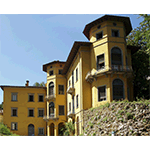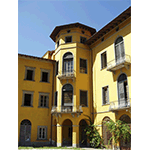Thermal Baths of Bagni di Lucca
Bagni di Lucca is a thermal station of very ancient origin, known in the Middle Ages by the name of Bagni di Corsena. A sonnet by Franco Sacchetti dedicated to Michele Guinigi shows how highly these thermal waters were considered:
"My dear Michele, when I look around me
At the place, and the virtue of this fountain,
I must believe that never under Phaeton
Was there a vein of such sweet waters .
Fine air has this place,
Flowing rivers at the foot of every mount,
Your costumes, and your women count,
With sweet enticing songs of sirens;
Wine, meat, fish, and all the wholesome fruits
And every other thing that comforts,
In which it seems this paradise delights.
Here every malady is cured, or fades away;
And even more, what is most sovereign,
Is that such virtue is by love accompanied."
On a less poetic but more scientific level were both Gentile Gentili da Foligno, who first described the therapeutic value of these springs, in the first half of the 14th century, and Ugolino da Montecatini. The latter, in his famous Tractatus de Balneis (CittÓ di Castello, 1417), wrote that the water of the baths "is most famous and devoid of any odour or taste... These baths are highly effective for pains in the joints and for nervous disorders, especially those caused by the cold. They are suitable for neuralgic pains and for diseases of the joints occurring either spontaneously or due to sprains or as the result of previous torture. They dry up ulcers and cure those that heal with difficulty. They are beneficial to childless women, allowing them to conceive when the sterility is due to humidity in the uterus, because their drying effect is useful in all of those diseases where drying is necessary."
The thermal station, which attracted important personages, was also praised by the philosopher Michel de Montaigne, who stayed there for over two months in 1581 seeking a cure for his kidney stones. The waters of the Baths were described by eminent physicians such as Gabriele Falloppia and Andrea Bacci in the 16th century, Lodovico Martini and Fabrizio Ardizzone in the 17th, Giuseppe Duccini, Giuseppe Zambeccari and Domenico Moscheni in the 18th century. Duccini, for example, stressed their effectiveness in expelling kidney stones: "The water of the Villa is marvellous, especially for the expulsion of Kidney stones, and Gravel, for cleansing ulcers and internal as well as external sores. [...] The patient staying in the Baths, and remaining there at least an hour with all due quiet, the skin is necessarily dampened little by little, and its recesses and pores open imperceptibly due to the heat of said Baths; so that, this warm water insinuating itself inside us, not only releases the internal organs, but also expands the paths, and the ducts of the kidneys, within which the stones were enclosed, and in this way gently promotes their expulsion". Slightly after the middle of the 19th century, the chemical and therapeutical properties of the various springs were analyzed by Alessandro Carina, at the time head physician of the baths.
Under the rule of Elisa Bonaparte Baciocchi, Bagni di Lucca flourished, becoming one of the most famous thermal centres in Italy and abroad, rivalling the nearby Baths of San Giuliano and those of Montecatini. Subsequently, the little town developed still further, both as a curative centre and as a resort, becoming one of the favourite stopping places in the cultured, refined nineteenth-century gran tour.
The waters gush from fifty-three springs at temperatures ranging from 39 to 54 degrees Centigrade. There are seven historic thermal establishments at Bagni di Lucca: in the Bagni Caldi locality is the Jean Varraud establishment, the only one still in operation at the moment, and the Bagno San Giovanni; at Ponte a Serraglio are the Bagno Cardinali, today a private residence, the Bagno Bernab˛, the Docce Basse, known also as Bagno Rosso, and the former Demidoff Hospital; lastly, above the main town is Bagno alla Villa, which remained in operation until the 1950s.
****************************
Texts by Graziano Magrini
English translation by Catherine Frost
Last update 09/feb/2008





